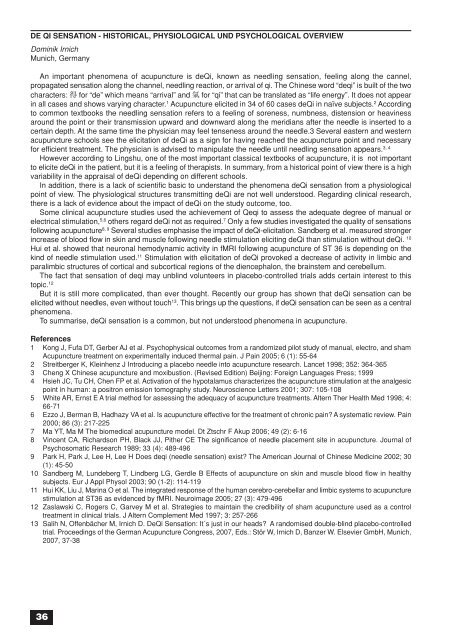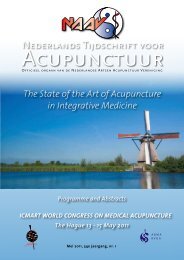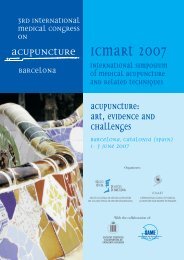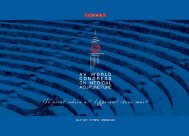Congress Abstracts full PDF - International Council of Medical ...
Congress Abstracts full PDF - International Council of Medical ...
Congress Abstracts full PDF - International Council of Medical ...
Create successful ePaper yourself
Turn your PDF publications into a flip-book with our unique Google optimized e-Paper software.
DE QI SENSATION - HISTORICAL, PHYSIOLOGICAL UND PSYCHOLOGICAL OVERVIEW<br />
Dominik Irnich<br />
Munich, Germany<br />
An important phenomena <strong>of</strong> acupuncture is deQi, known as needling sensation, feeling along the cannel,<br />
propagated sensation along the channel, needling reaction, or arrival <strong>of</strong> qi. The Chinese word “deqi” is built <strong>of</strong> the two<br />
characters: 得 for “de” which means “arrival” and 氣 for “qi” that can be translated as “life energy”. It does not appear<br />
in all cases and shows varying character. 1 Acupuncture elicited in 34 <strong>of</strong> 60 cases deQi in naïve subjects. 2 According<br />
to common textbooks the needling sensation refers to a feeling <strong>of</strong> soreness, numbness, distension or heaviness<br />
around the point or their transmission upward and downward along the meridians after the needle is inserted to a<br />
certain depth. At the same time the physician may feel tenseness around the needle.3 Several eastern and western<br />
acupuncture schools see the elicitation <strong>of</strong> deQi as a sign for having reached the acupuncture point and necessary<br />
for efficient treatment. The physician is advised to manipulate the needle until needling sensation appears. 3, 4<br />
However according to Lingshu, one <strong>of</strong> the most important classical textbooks <strong>of</strong> acupuncture, it is not important<br />
to elicite deQi in the patient, but it is a feeling <strong>of</strong> therapists. In summary, from a historical point <strong>of</strong> view there is a high<br />
variability in the appraisal <strong>of</strong> deQi depending on different schools.<br />
In addition, there is a lack <strong>of</strong> scientific basic to understand the phenomena deQi sensation from a physiological<br />
point <strong>of</strong> view. The physiological structures transmitting deQi are not well understood. Regarding clinical research,<br />
there is a lack <strong>of</strong> evidence about the impact <strong>of</strong> deQi on the study outcome, too.<br />
Some clinical acupuncture studies used the achievement <strong>of</strong> Qeqi to assess the adequate degree <strong>of</strong> manual or<br />
electrical stimulation, 5,6 others regard deQi not as required. 7 Only a few studies investigated the quality <strong>of</strong> sensations<br />
following acupuncture 8, 9 Several studies emphasise the impact <strong>of</strong> deQi-elicitation. Sandberg et al. measured stronger<br />
increase <strong>of</strong> blood flow in skin and muscle following needle stimulation eliciting deQi than stimulation without deQi. 10<br />
Hui et al. showed that neuronal hemodynamic activity in fMRI following acupuncture <strong>of</strong> ST 36 is depending on the<br />
kind <strong>of</strong> needle stimulation used. 11 Stimulation with elicitation <strong>of</strong> deQi provoked a decrease <strong>of</strong> activity in limbic and<br />
paralimbic structures <strong>of</strong> cortical and subcortical regions <strong>of</strong> the diencephalon, the brainstem and cerebellum.<br />
The fact that sensation <strong>of</strong> deqi may unblind volunteers in placebo-controlled trials adds certain interest to this<br />
topic. 12<br />
But it is still more complicated, than ever thought. Recently our group has shown that deQi sensation can be<br />
elicited without needles, even without touch 13 . This brings up the questions, if deQi sensation can be seen as a central<br />
phenomena.<br />
To summarise, deQi sensation is a common, but not understood phenomena in acupuncture.<br />
References<br />
1 Kong J, Fufa DT, Gerber AJ et al. Psychophysical outcomes from a randomized pilot study <strong>of</strong> manual, electro, and sham<br />
Acupuncture treatment on experimentally induced thermal pain. J Pain 2005; 6 (1): 55-64<br />
2 Streitberger K, Kleinhenz J Introducing a placebo needle into acupuncture research. Lancet 1998; 352: 364-365<br />
3 Cheng X Chinese acupuncture and moxibustion. (Revised Edition) Beijing: Foreign Languages Press; 1999<br />
4 Hsieh JC, Tu CH, Chen FP et al. Activation <strong>of</strong> the hypotalamus characterizes the acupuncture stimulation at the analgesic<br />
point in human: a positron emission tomography study. Neuroscience Letters 2001; 307: 105-108<br />
5 White AR, Ernst E A trial method for assessing the adequacy <strong>of</strong> acupuncture treatments. Altern Ther Health Med 1998; 4:<br />
66-71<br />
6 Ezzo J, Berman B, Hadhazy VA et al. Is acupuncture effective for the treatment <strong>of</strong> chronic pain A systematic review. Pain<br />
2000; 86 (3): 217-225<br />
7 Ma YT, Ma M The biomedical acupuncture model. Dt Ztschr F Akup 2006; 49 (2): 6-16<br />
8 Vincent CA, Richardson PH, Black JJ, Pither CE The significance <strong>of</strong> needle placement site in acupuncture. Journal <strong>of</strong><br />
Psychosomatic Research 1989; 33 (4): 489-496<br />
9 Park H, Park J, Lee H, Lee H Does deqi (needle sensation) exist The American Journal <strong>of</strong> Chinese Medicine 2002; 30<br />
(1): 45-50<br />
10 Sandberg M, Lundeberg T, Lindberg LG, Gerdle B Effects <strong>of</strong> acupuncture on skin and muscle blood flow in healthy<br />
subjects. Eur J Appl Physol 2003; 90 (1-2): 114-119<br />
11 Hui KK, Liu J, Marina O et al. The integrated response <strong>of</strong> the human cerebro-cerebellar and limbic systems to acupuncture<br />
stimulation at ST36 as evidenced by fMRI. Neuroimage 2005; 27 (3): 479-496<br />
12 Zaslawski C, Rogers C, Garvey M et al. Strategies to maintain the credibility <strong>of</strong> sham acupuncture used as a control<br />
treatment in clinical trials. J Altern Complement Med 1997; 3: 257-266<br />
13 Salih N, Offenbächer M, Irnich D. DeQi Sensation: It´s just in our heads A randomised double-blind placebo-controlled<br />
trial. Proceedings <strong>of</strong> the German Acupuncture <strong>Congress</strong>, 2007, Eds.: Stör W, Irnich D, Banzer W. Elsevier GmbH, Munich,<br />
2007, 37-38<br />
36







